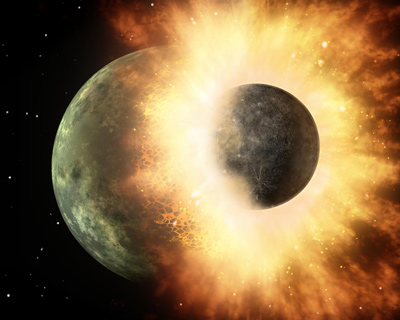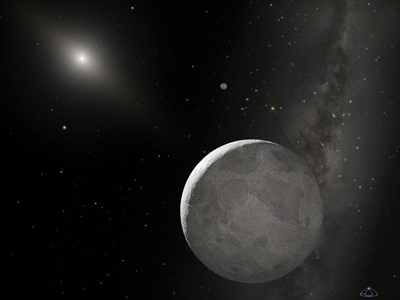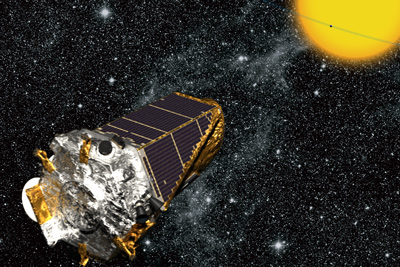Doomsday from Rogue Planets
by Andrew Fraknoi and the Calendar in the Sky Team
One popular suggestion for how the world might end in 2012 is that there is a “rogue planet” out there -- not in a safe orbit circling the Sun, but moving inward toward the Sun on a collision course with Earth.

This artist's concept shows a celestial body about the size of our Moon slamming at great speed into a body the size of Mercury. NASA's Spitzer Space Telescope found evidence that a high-speed collision of this sort occurred a few thousand years ago around a young star, called HD 172555, still in the early stages of planet formation. The star is about 100 light-years from Earth. Some worry Earth will suffer a similar fate in 2012, but they shouldn’t. (Image credit: NASA/JPL-Caltech)
Popular names for this mysterious planet include Nibiru, Nemesis, Tyche, Hecubolus, or simply Planet X, and each name comes from some complicated story or idea popularized on the Web. None of them are true. For example, Nibiru was the name of a god in the mythology of the ancient Sumerians. A completely fictional planet by that name was popularized in a series of books by a self-taught archaeologist, who claimed (with no verifiable evidence) that there was an inhabited “12th planet” in the Solar System and that the origin of humanity was connected with aliens from this distant world. These books are part of a whole bizarre category of “fiction claimed as fact,” in which ancient alien astronauts come to Earth and are responsible for human development.
It takes only a little thought to show (especially now that it’s already December) how unlikely it is that a planet could be on its way to collide with or influence the Earth on Dec. 21, 2012. Planets are seen in the sky because they reflect the light of the Sun. Sometimes the planet Venus (our neighbor in the Solar System) is seen as the brightest point of light in the evening or dawn sky.
In the same way, this threatening planet -- that will supposedly cause Doomsday -- would have to be very close to us by now, and it would surely be one of the brightest things in the sky. Thousands of professional astronomers and hundreds of thousands of amateur astronomers around the world would be observing and tracking this world, and it would dominate the news, eclipsing such “minor” stories as government deficits or civil wars. There would be no possible way this could remain a secret (known only among a few insiders) and not be causing huge waves of panic all over the Earth.
In addition, if a previously uncharted, but dangerously large object were heading toward the Earth, its gravity would long ago have disturbed the clockwork motions of the planets and moons we already know. As such a world came closer and closer to us (say from the outer parts of the Solar System), its passage would affect the orbits of the other planets, such as Mars. Even if the rogue planet had somehow evaded detection, the changes in the movement of the known planets would immediately have alerted us to something moving through the Solar System. No such changes have been seen.
Incidentally, the author of the books about aliens from the planet Nibiru originally predicted that this planet would come into the inner solar system in the year 2900. Only recently did his prediction get turned into a 2012 doomsday scenario.

An artist’s view of the newly discovered dwarf planet, Eris and its moon Dysnomia. The view here looks toward the Sun, which is merely a very bright star at a distance of over 10 billion miles. Astronomers are finding many such worlds in the outer reaches of the Solar System.
(Image credit: NASA/ESA/STScI)
The story of the rogue planet has been so popular, however, that it makes astronomers wonder why people believe these claims. One idea is that there have been so many real stories in the news recently about newly discovered planets, that one more such discovery might not seem so far-fetched. So let’s take a look at what sorts of planets scientists have actually been discovering and where these planets are.
In the last decade, there has been quite a bit of discussion in the media of Pluto being “kicked out of the big planet club.” This is in part because other small (or dwarf) planets – orbiting beyond Pluto – have been found. We now know that Pluto is part of a large belt of smaller worlds – like the asteroid belt between Mars and Jupiter, but further out. Some of the other members of this belt of “plutos” include dwarf planets called Eris, Makemake, and Haumea. Their names are drawn from mythologies around the world, so if someone wants to suggest another outer planet called Nibiru, the average person would probably shrug and say “Why not?” The difference is that Pluto’s brothers and sisters have been observed through telescopes and carefully charted, while Nibiru appears to be a figment of some overactive imaginations.
If a large planet, like something the size of Jupiter, were in our Solar System really far from the Sun, the amount of sunlight it reflects back to Earth might be too small to be picked up by our telescopes. A better way to find such a planet would be using infrared light, which is given off by objects too cool to glow with visible light. (The Earth and other known planets are all easily detected using infrared.) An infrared telescope in space, called WISE (Wide-field Infrared Survey Explorer) scanned the skies from 2009 through 2011. Astronomers are still analyzing the information it sent back, but, so far, no large planets far from the Sun have been found. And even if we do find a faint glow indicating that one is out there, it would be much too far away to be a danger to us.

NASA’s Kepler spacecraft is seen here in an artist’s illustration. The Kepler mission discovers new planets beyond our Solar System by monitoring hundreds of thousands of stars for signs of tiny eclipses causes by planets passing in front of their parent star.
(Image credit: NASA/Kepler mission/Wendy Stenzel)
So it seems we will not be able to count on a new planet to determine the fate of our civilization after all. Much more likely, our future destiny will be governed by how well we take care of the one planet we currently inhabit.
1681